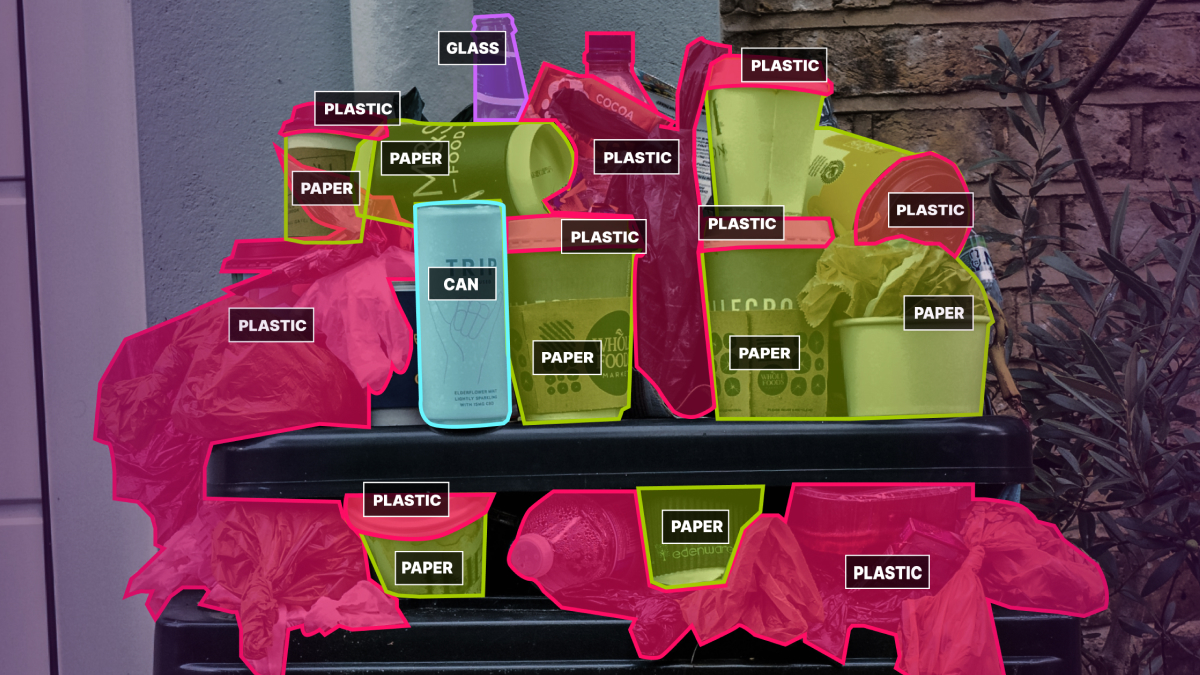Companies and Organizations Can Leverage AI to Improve Recycling
Recently, our team worked on an image annotation project that enabled AI systems to sort through waste baskets and separate materials that can be recycled from ones that can’t. This technology would allow companies to reduce the amount of waste that ends in landfills and increase sustainability levels. Recycling is proving to be a big challenge for even the world’s largest economies. According to recent data, every year, more than 90 million tons of recyclable material end up in United States landfills. One of the biggest reasons for this is that items that cannot be recycled are mixed in with the ones that can.
In fact, it is estimated that, on average, 1 in every 4 items in recycling bins is a non-recyclable item. Now, this problem is worse than the numbers may suggest. The US doesn’t have the needed infrastructure to handle recycling efforts on a massive scale, so it relied on China for them. However, this issue of mixing recyclable materials with garbage has become so severe that China started rejecting recycling. This signifies a need for a change in the way recycling is done in the US. One possible solution to the waste issue is using AI robots to enhance our recycling efforts. However, this issue with mixing recyclable materials with garbage has been
In this article, we will take a look at how AI can improve recycling efforts and the data annotation that is essential to create a smarter way to recycle.
Sorting Waste and Recyclables
While there are usually recycling bins next to garbage in many cities around the world and in many offices as well, a lot of people throw their trash in the recycling bins or, vice-versa, items that should be recycled are placed in the garbage. One of the ways recyclables are separated from trash items is through optical sorting. Basically, these are machines that use reflected light to analyze products that have been simulated and presented to the viewing area. This singulation can be achieved utilizing low-friction inclined chutes or conveyor belts. Specially designed optical filters narrow the reflected light into specific wavelengths that accentuate the difference between the acceptable product and the product to be rejected. Specialized CCD, IR, UV, or RGB (full color red/green/blue) cameras receive the reflected light from the product and send this information to be amplified and classified.
While optical sorting is definitely better than manual work, new developments in AI pave the way for even greater efficiency. New, smart garbage bins have been developed that actually sort garbage from the recyclables. A great example of this is the TrashBot. Through recycling AI, robotics, computer vision, and machine learning, the AI recycling technology diverts each item into its corresponding bin inside the TrashBot, assigning any contaminated items into the landfill bin or organics into their corresponding bins. According to the company’s website, the system is able to complete its sorting duties with an accuracy of 95%.

Distinguishing Between the Various Types of Recyclable Items
When we dive deeper into the various types of items that can be recycled, we see that there are many different types of paper, metals, plastics, and other materials. Are all metals, for example, recyclable? What we know is that some materials are more difficult to recycle than others. In fact, some materials are almost impossible to recycle. A great example of this is the paper coffee cups that you can find in places like Starbucks and other cafes. While it may appear that the entire cup is made out of paper, the vast majority of these cups contain a thin plastic film that keeps the cups watertight, and due to this, they almost always end up in the landfill.
So how can businesses, governments, and NGOs achieve higher recycling rates and supply greater volumes of post-consumer recycled content? Once again, AI may hold the key. There are AI systems that use computers to map millions of images of material streams to identify different types of papers, plastics, and metals. The computer vision identifies patterns of specific recyclable materials within a complex waste stream of smashed, folded, and tattered objects — all combined together. It then distinguishes different plastic polymers, types of paper, metal containers, and multilayered packages to characterize what’s in the recycling stream and what needs to be sorted during different process stages.
What Types of Data Annotation are Required to Create AI Recycling Technology?
When we look at AI-powered recycling technology, we see that it relies heavily on computer vision. What this means is that the AI system needs to identify and classify each type of item it encounters. In order to train the machine learning algorithms, researchers use images of various recyclable and non-recyclable items as training data. This dataset needs to be annotated with simple labeling, where data annotators simply label each item as recyclable or non-recyclable. Instance segmentation will also be necessary to identify the various types of items found in bins. This is a special form of image segmentation that deals with detecting instances of objects and demarcating their boundaries. Our team performed this type of data annotation in the case study mentioned in the very beginning of the article. You can read more about it here.
Trust Mindy Support With All of Your Data Annotation Needs
Mindy Support is a global company for data annotation and business process outsourcing, trusted by Fortune 500 and GAFAM companies, as well as innovative startups. With nine years of experience under our belt and offices and representatives in Cyprus, Poland, Romania, The Netherlands, India, UAE and Ukraine, Mindy Support’s team now stands strong with 2000+ professionals helping companies with their most advanced data annotation challenges.





